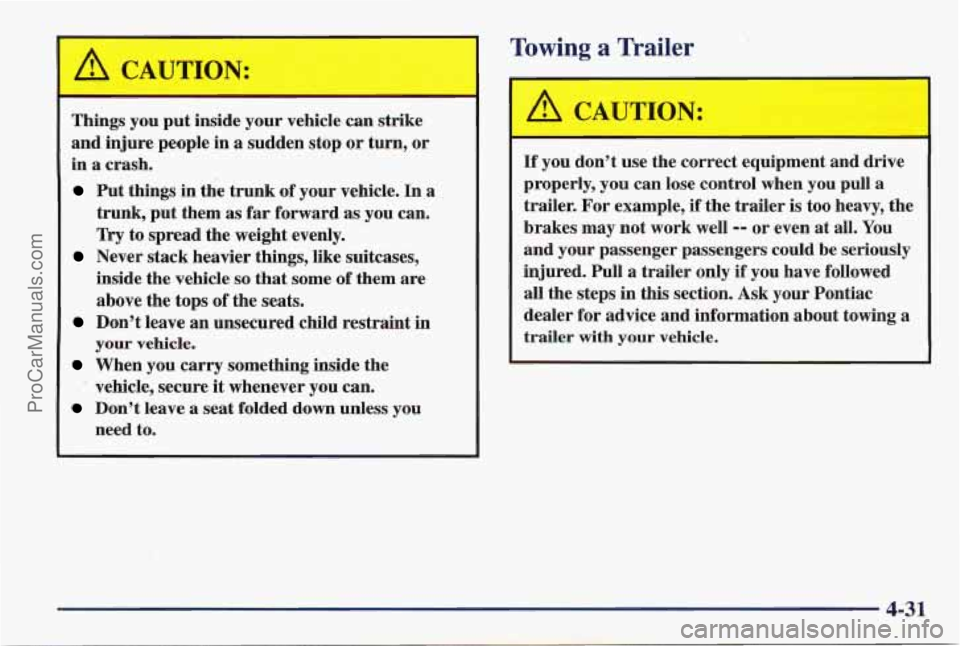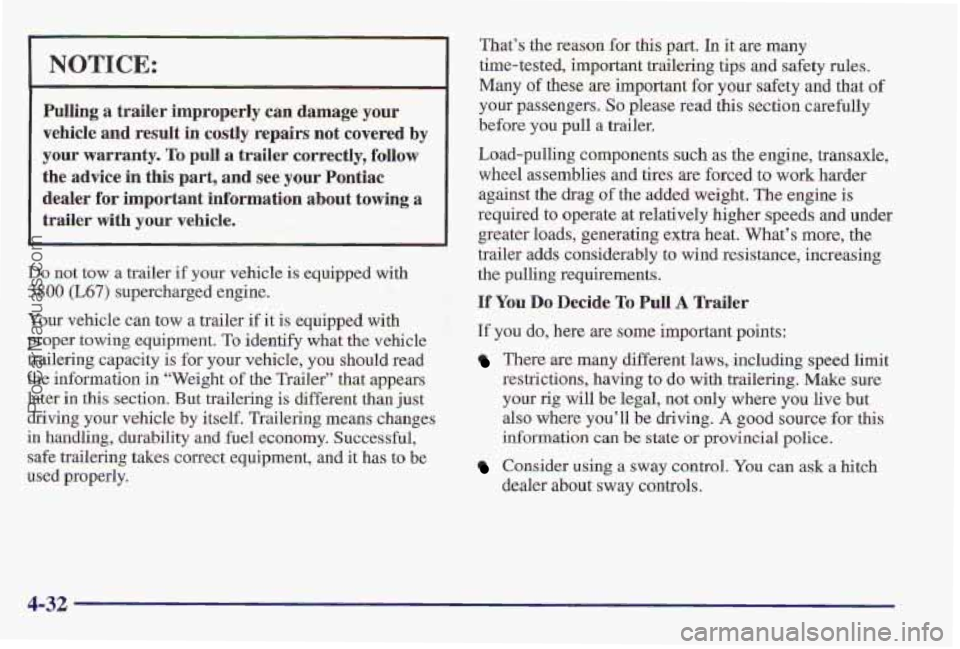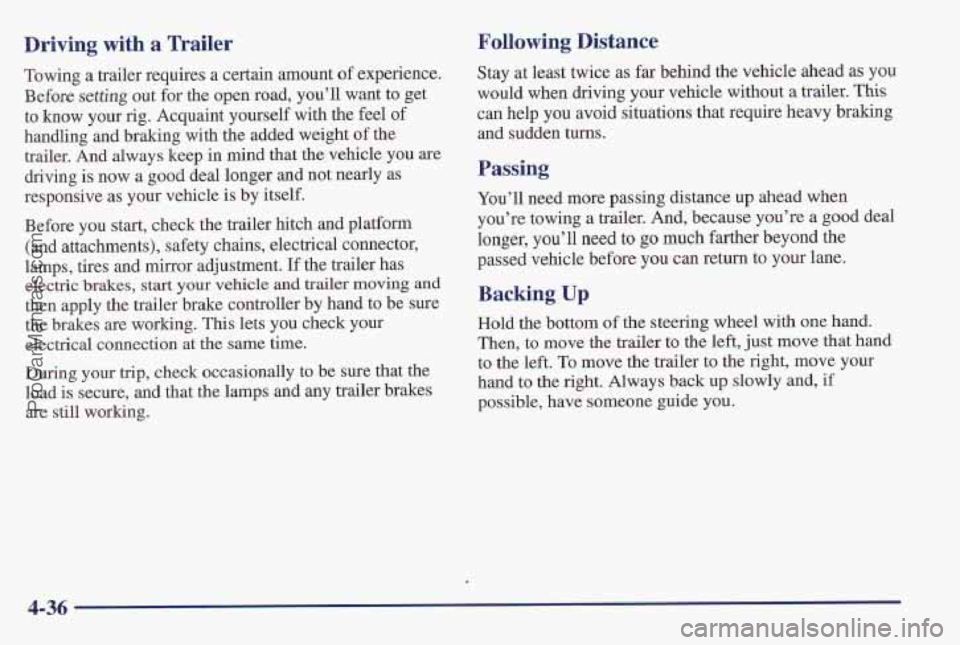1997 PONTIAC PONTIAC towing
[x] Cancel search: towingPage 145 of 419

NOTICE:
If you keep driving your vehicle with this light
on, after a while, your emission controls may not
work as well, your fuel economy may not be as
good and your engine may not run as smoothly.
This could lead to costly repairs that may not be
covered by your warranty.
This light should come on, as a check to show you it is
working, when the ignition
is on and the engine is not
running.
If the light doesn’t come on, have it repaired.
This light will also come on during a malfunction in one
of two ways:
0 Light Flashing -- A misfire condition has been
detected.
A misfire increases vehicle emissions and
may damage the emission control system on your
vehicle. Dealer
or qualified service center diagnosis
and service is required.
Light On Steady -- An emission control system
malfunction has been detected on your vehicle.
Dealer or qualified service center diagnosis and
service
may be required.
If the Light Is Flashing
The following may prevent more serious damage to
your vehicle:
Reducing vehicle speed.
Avoiding hard accelerations.
Avoiding steep uphill grades.
If you are towing a trailer, reduce the amount of
cargo being hauled as
soon as it is possible.
If the light stops flashing and remains on steady, see “If
the Light
Is On Steady” following.
If the light continues to flash, when it is safe to do
so,
stop the vehicle. Find a safe place to park your vehicle.
Turn the key off, wait at least 10 seconds and restart the
engine.
If the light remains on steady, see “If the Light
Is On Steady” following. If the light is still flashing,
follow the previous steps, and drive the vehicle to your
dealer or qualified service center for service.
2-71
ProCarManuals.com
Page 195 of 419

I
Section 4 Your Driving and the Road
Here you’ll find information about driving on different kinds of roads and in varying weather conditions. We’ve also
included many other useful tips on driving.
4-2
4-3
4-6
4-6
4-7
4-9
4-11
4-11
4-13
4-13 Defensive
Driving
Driving Drunk
Having Control
of Your Vehicle
Your Braking System Information
Anti-Lock Brake Information
Trac System
Braking in Emergencies
Steering Tips
Off-Road
Recovery Tips
Passing Other Vehicles 4-
15
4-16
4-
17
4-22 4-23
4-23 4-25
4-27
4-29
4-3 1
Losing Control of Your Vehicle
Night Driving
Driving in Rain and on Wet Roads
Tips Before Leaving on a Long Trip
Avoiding Highway Hypnosis
Driving on Hills and Mountains
Winter Driving
If You’re Caught in
a Blizzard
Loading
Your Vehicle
Helpful Hints for Towing a Trailer
4-1
.- ;.. i .,;,;.L. ._ r _- , . .. - .. .. ProCarManuals.com
Page 225 of 419

I
Towing a Trailer
Things you put inside your vehicle can strike
and injure people
in a sudden stop or turn, or
in
a crash.
Put things in the trunk of your vehicle. In a
1 trunk, put them as far forward as you can.
Never stack heavier things, like suitcases,
Try to spread the weight evenly.
inside the vehicle
so that some of them are
above the tops
of the seats.
Don’t leave an unsecured child restraint in
your vehicle.
When you carry something inside the
’ vehicle, secure it whenever you can.
Don’t leave a seat folded down unless you
need to.
If you don’t use the correct equipment and drive
properly, you can lose control when you pull
a
trailer. For example, if the trailer is too heavy, the
brakes may not work well
-- or even at all. You
and your passenger passengers could be seriously
injured. Pull
a trailer only if you have followed
all the steps in this section. Ask your Pontiac
dealer
for advice and information about towing a
trailer
with your vehicle.
4-31
ProCarManuals.com
Page 226 of 419

?‘hat’s me reason for this part. In it are many
Many of these are important
for your safety and that of
your passengers. So please read this section carefully
before you pull a trailer.
NOTICE: time-tested, important trailering tips and safety rules.
Pulling a trailer improperly can damage your
vehicle and result in costly repairs not covered
by
your warranty. To pull a trailer correctly, follow Load-pulling components such as the engine, transaxle,
the advice in this part, and see your Pontiac wheel assemblies and tires are forced to work harder
dealer for important information about towing a against the drag of the added weight. The engine is
trailer with your vehicle. required to sperate at relatively higher speeds and under
greater loads, generating extra heat. What’s more, the
trailer adds considerably to wind resistance, increasing
If You Do Decide To Pull A Trailer
If you do, here are some important points:
Do not tow a trailer if your vehicle is equipped with the pulling requirements.
3800 (L67) supercharged engine.
Your vehicle can tow
a trailer if it is equipped with
proper towing equipment.
To identify what the vehicle
trailering capacity is for your vehicle, you should read
There are many different laws, including speed limit
the information in “Weight of the Trailer” that appears restrictions, having to do with trailering. Make sure
later
in this section. But trailering is different than just your rig will be legal, not only where you live but
driving your vehicle by itself, Trailering means changes also where you’ll be driving.
A good source for this
in handling, durability and fuel economy. Successful, information
can be state or provincial police.
safe trailering takes correct equipment, and it has to be
Consider using a sway control. You can ask a hitch
used Droperly. dealer about
sway controls.
4-32
ProCarManuals.com
Page 227 of 419

0
0
0
Don’t tow a trailer at all during the first 1,000 miles
(1 600 km) your new vehicle is driven. Your engine,
axle or other parts could be damaged.
Then, during the first
500 miles (800 km) that you
tow a trailer, don’t drive over
50 mph (80 km/h) and
don’t make
starts at full throttle. This helps your
engine and other parts of your vehicle wear in at the
heavier loads.
Obey speed limit restrictions when towing a trailer.
Don’t drive faster than the maximum posted speed
for trailers (or no more than
55 mph (90 kdh)) to
save wear
on your vehicle’s parts.
Three important considerations have to
do with weight:
0 the weight of the trailer,
the weight of the trailer tongue
and the total weight on your vehicle’s tires.
Weight of the Trailer
How heavy can a trailer safely be?
It should never weigh more than
1,000 pounds (450 kg).
But even that can be too heavy.
It depends on how you plan to use your rig. For
example, speed, altitude, road grades, outside
temperature and how much your vehicle is used to pull a trailer
are all important. And, it can also depend on any
special equipment that you have on your vehicle.
You can ask
your dealer for our trailering information or
advice, or you can write us at:
Customer Assistance Center
Pontiac Division, One Pontiac Plaza
Pontiac, MI 48340-2952
In Canada, write to:
General Motors of Canada Limited
Customer Communication Centre
1908 Colonel Sam Drive
Oshawa, Ontario L1H 8P7
Weight sf the Trailer Tongue
The tongue load (A) of any trailer is an important
weight to measure because it affects the total capacity
weight
of your vehicle. The capacity weight includes the
curb weight of the vehicle, any cargo you may carry in
it, and the people who will
be riding in the vehicle. And
if you will tow a trailer, you must subtract the tongue
load from your vehicle’s capacity weight because your
vehicle will be carrying that weight, too. See “Loading
Your Vehicle” in the Index for more information
about
your vehicle’s maximum load capacity.
4-33
ProCarManuals.com
Page 230 of 419

Driving with a Trailer Following Bistance
Towing a trailer requires a certain amount of experience.
Before setting out for the open road, you’ll want to get
to know your rig. Acquaint yourself with the feel
of
handling and braking with the added weight of the
trailer. And always keep in mind that the vehicle you
are
driving is now a good deal longer an’d not nearly as
responsive as your vehicle
is by itself.
Before you start, check the trailer hitch and platform
(and attachments), safety chains, electrical connector,
lamps, tires and mirror adjustment. If the trailer has
electric brakes, start your vehicle
and trailer moving and
then apply the trailer brake controller by hand to be sure
the brakes
are working. This lets you check your
electrical connection at the same time.
During your trip, check occasionally to be sure that the
load
is secure, and that the lamps and any trailer brakes
are still working, Stay
at least twice as far behind the vehicle ahead as you
would when driving
your vehicle without a trailer. This
can help you avoid situations that require heavy bralung
and sudden turns.
Passing
You’ll need more passing distance up ahead when
you’re towing a trailer. And, because you’re
a good deal
longer, you’ll need to
go much farther beyond the
passed vehicle before you can return to your lane.
Backing Up
Hold the bottom of the steering wheel with one hand.
Then, to move the trailer to the left, just
move that hand
to the left.
To move the trailer to the right, move your
hand to the right. Always back up slowly and,
if
possible, have someone guide you.
4-36
ProCarManuals.com
Page 231 of 419

Making Turns
I NOTICE:
Making very sharp turns while trailering could cause the trailer to come in contact with the
vehicle. Your vehicle could be damaged. Avoid making very sharp turns while trailering.
When you’re turning with a trailer, make wider turns than
normal.
Do this so your trailer won’t strike soft shoulders,
curbs, road signs, trees or other objects. Avoid jerky or
sudden maneuvers. Signal well in advance.
Turn Signals When Towing a Trailer
When you tow a trailer, your vehicle may need a
different turn signal flasher andlor extra wiring. Check
with your Pontiac dealer. The green arrows on your
instrument panel will flash whenever you signal a turn
or lane change. Properly hooked up, the trailer lamps
will also flash, telling other drivers you’re about to turn,
change lanes or stop. When towing
a trailer, the green
arrows on your
instrument panel will flash for turns even if the bulbs on
the trailer are burned out. Thus, you may think drivers
behind you are seeing your signal when they are not. It’s
important to check occasionally to be
sure the trailer
bulbs
are still working.
Your vehicle has bulb warning lights. When you plug
a
trailer lighting system into your vehicle’s lighting
system, its bulb warning lights may not
let you know if
one of your lamps goes out. So, when you have a trailer
lighting system plugged in, be sure to check your
vehicle and trailer lamps
from time to time to be sure
they’re all working. Once you disconnect the trailer
lamps, the bulb warning lights again can tell you if one
of your vehicle lamps is out.
Driving On Grades
Reduce speed and shift to a lower gear before you start
down a long or steep downgrade. If you don’t shift
down, you might have to use your brakes
so much that
they would get hot and no longer work well.
On
a long uphill grade, shift down and reduce your
speed to around
45 mph (70 kd) to reduce the
possibility
of engine and transaxle overheating.
If you have Overdrive, you may want to drive in
THIRD (3), instead of DRIVE (D),
4-37
ProCarManuals.com
Page 232 of 419

Parking on Hills
You really should not park your vehicle, with a trailer
attached,
on a hill. If something goes wrong, your rig
could start to move. People
can be injured, and both
your vehicle and the trailer can be damaged.
But
if you ever have to park your rig on a hill, here’s
how to do it:
1. Apply your regular brakes, but don’t shift into
2. Have someone place chocks under the trailer wheels.
3. When the wheel chocks are in place, release the
regular brakes until the chocks absorb the load.
4. Reapply the regular brakes. Then apply your parking
brake, and then shift to
FARM (P).
5. Release the regular brakes.
PARK (P) yet,
When You Are Ready to Leave After
Parking on a Hill
1. Apply your regular brakes and hold the pedal down
while you:
Start your engine;
Shift into a gear; and
0 Release the parking brake.
2. Let up on the brake pedal.
3. Drive slowly until the trailer is clear of the chocks.
4. Stop and have someone pick up and store the chocks.
Maintenance When Trailer Towing
Your vehicle will need service more often when you’re
pulling
a trailer. See the Maintenance Schedule for more
on this. Things that are especially important in trailer
operation are automatic transaxle fluid (don’t overfill),
engine oil, belts, belt, cooling system and brake
adjustment. Each
of these is covered in this manual, and
the Index will
help you find them quickly. If you’re
trailering, it’s a good idea to review these sections
before you start your trip.
Check periodically to see that all hitch nuts and bolts
are tight.
4-38
ProCarManuals.com